Functionalized Aluminum Reagents
Vielhaber; Margaret Flook ; et al.
U.S. patent application number 16/400088 was filed with the patent office on 2020-11-05 for functionalized aluminum reagents. The applicant listed for this patent is The Goodyear Tire & Rubber Company. Invention is credited to Seth Cody Ensign, Margaret Flook Vielhaber.
| Application Number | 20200347083 16/400088 |
| Document ID | / |
| Family ID | 1000004094562 |
| Filed Date | 2020-11-05 |








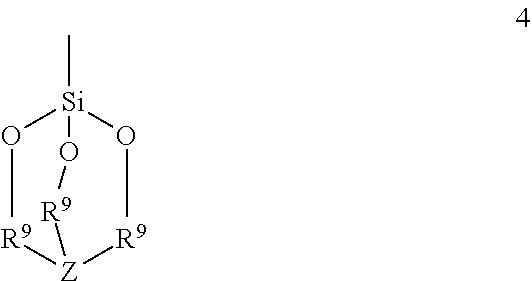


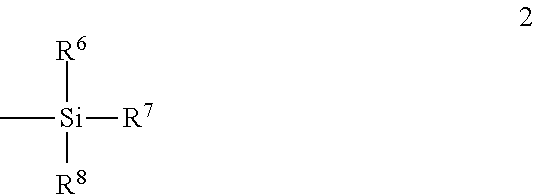
View All Diagrams
| United States Patent Application | 20200347083 |
| Kind Code | A1 |
| Vielhaber; Margaret Flook ; et al. | November 5, 2020 |
FUNCTIONALIZED ALUMINUM REAGENTS
Abstract
The invention is directed to functionalized aluminum reagents of formula 1 ##STR00001## where R is a linear or branched alkane group containing 1 to 8 carbon atoms, and R.sup.1 is phenylene, or a linear or branched alkane diyl group containing 2 to 10 carbon atoms, or a combination of one or more phenylene groups and one or more linear or branched alkane diyl groups containing 1 to 10 carbon atoms; Q is of formula 2 ##STR00002## where R.sup.5, R.sup.6 and R.sup.7 are independently a linear or branched alkyl group containing 1 to 3 carbon atoms or a group of formula 3 ##STR00003## where R.sup.3 and R.sup.4 are independently phenyl or a linear or branched alkyl group containing 1 to 10 carbon atoms, or R.sup.3 and R.sup.4 taken together with the nitrogen atom represent a nitrogen containing heterocyclic group containing from 4 to 12 carbon atoms; or R.sup.5, R.sup.6 and R.sup.7 taken together with the silicon atom represent a structure of formula 4 ##STR00004## where R.sup.8 is C1 to C4 linear or branched alkanediyl and Z is N or a group of formula 5 ##STR00005## wherein R.sup.13 is C1 to C8 alkyl.
| Inventors: | Vielhaber; Margaret Flook; (Kent, OH) ; Ensign; Seth Cody; (Akron, OH) | ||||||||||
| Applicant: |
|
||||||||||
|---|---|---|---|---|---|---|---|---|---|---|---|
| Family ID: | 1000004094562 | ||||||||||
| Appl. No.: | 16/400088 | ||||||||||
| Filed: | May 1, 2019 |
| Current U.S. Class: | 1/1 |
| Current CPC Class: | C08K 5/56 20130101; C08F 36/06 20130101; C07F 7/10 20130101 |
| International Class: | C07F 7/10 20060101 C07F007/10 |
Claims
1. A functionalized aluminum reagent of formula 1 ##STR00019## wherein R is a linear or branched alkane group containing 1 to 8 carbon atoms, and R.sup.1 is phenylene, or a linear or branched alkane diyl group containing 2 to 10 carbon atoms, or a combination of one or more phenylene groups and one or more linear or branched alkane diyl groups containing 1 to 10 carbon atoms; Q is of formula 2 ##STR00020## wherein R.sup.6, R.sup.7 and R.sup.8 are independently a linear or branched alkyl group containing 1 to 3 carbon atoms or a group of formula 3 ##STR00021## where R.sup.3 and R.sup.4 are independently phenyl or a linear or branched alkyl group containing 1 to 10 carbon atoms wherein at least one of R.sup.6, R.sup.7 and R.sup.8 is of formula 3, or R.sup.3 and R.sup.4 taken together with the nitrogen atom represent a nitrogen containing heterocyclic group containing from 4 to 12 carbon atoms; or R.sup.6, R.sup.7 and R.sup.8 taken together with the silicon atom represent a structure of formula 4 ##STR00022## wherein R.sup.9 is C1 to C4 linear or branched alkanediyl and Z is N or a group of formula 5 ##STR00023## wherein R.sup.13 is C1 to C8 alkyl.
2. The functionalized aluminum reagent of claim 1, selected from the group consisting of ##STR00024##
3. A method of making the functionalized aluminum reagent of claim 1, comprising the step of reaction of an olefinic silane 6 with a dialkyl aluminum hydride 7 in the presence of a neodymium catalyst ##STR00025## wherein R.sup.5 is phenylene, or a linear or branched alkane diyl group containing 1 to 9 carbon atoms, or a combination of one or more phenylene groups and one or more linear or branched alkane diyl groups containing 1 to 10 carbon atoms, and R and Q are as previously defined.
Description
BACKGROUND
[0001] Coordinative chain transfer polymerization (CCTP) using main group metals, i.e. a reversible chain transfer of polymeryl chains between chain growth active metal centers and chain growth inactive metal centers, has become an important strategy in insertion polymerization to reduce the amount of polymerization catalysts, to control the molecular weight and molecular weight distribution of polymers as well as to introduce chain end-functionalization by appropriate quenching of main group metal polymeryls. See Valente et al., Chem. Rev. 2013, 113, 3836-3857; Jian et al., Chem. Commun. 2010, 46, 3022-3024; German et al., Angew. Chem. Int. Ed. 2013, 52, 3438-3441. (b) Norsic et al., Angew. Chem. Int. Ed. 2015, 54, 4631-4635; Makio et al., J. Am. Chem. Soc. 2013, 135, 8177-8180.
[0002] Most commonly, commercially available un-functionalized aluminum and zinc alkyls have been employed, with zinc alkyls much better performing in terms of transfer efficiency and thus molecular weight control. With respect to heteroatom-functionalized main group metal alkyls, recently homoleptic di(o-aminoalkyl) magnesium reagents have been used as chain transfer reagents to yield end functionalized amino polyethylenyl magnesiums (Ottou et al., Macromolecules 2017, 50, 8372-8377.) Functionalized magnesium reagents were also employed to initiate polybutadiene chain growth to end-functionalized high trans polybutadiene (Leicht et al., Macromolecules 2018, 51, 763-770.), or with increased chain transfer numbers, to functionalized polybutadienes of less uniform stereochemistry (WO201013945.)
[0003] In contrast, both in organic synthesis and in polymer chemistry, heteroatom-functionalized aluminum reagents have scarcely been used as synthetically useful reactants for the transfer of functional group substituted carbon nucleophiles probably owing to drawbacks in the synthesis of homoleptic aluminum alkyls or the expectedly low chemoselectivity of mixed aluminum alkyls (Xu et al., Acc. Chem. Res. 2016, 49, 2158-2168; Gao et al., J. Am. Chem. Soc., 2010, 132, 10961-10963; May et al., Org. Lett., 2011, 13, 3040-3043.)
SUMMARY
[0004] The present invention is directed to functionalized aluminum reagents of formula 1
##STR00006##
where R is a linear or branched alkane group containing 1 to 8 carbon atoms, and R.sup.1 is phenylene, or a linear or branched alkane diyl group containing 2 to 10 carbon atoms, or a combination of one or more phenylene groups and one or more linear or branched alkane diyl groups containing 1 to 10 carbon atoms; Q is of formula 2
##STR00007##
where R.sup.6, R.sup.7 and R.sup.8 are independently a linear or branched alkyl group containing 1 to 3 carbon atoms or a group of formula 3
##STR00008##
where R3 and R4 are independently phenyl or a linear or branched alkyl group containing 1 to 10 carbon atoms, or R3 and R4 taken together with the nitrogen atom represent a nitrogen containing heterocyclic group containing from 4 to 12 carbon atoms; or R.sup.6, R.sup.7 and R.sup.8 taken together with the silicon atom represent a structure of formula 4
##STR00009##
where R.sup.9 is C1 to C4 linear or branched alkanediyl and Z is N or a group of formula 5
##STR00010##
wherein R.sup.13 is C1 to C8 alkyl.
[0005] There is further disclosed a method of making functionalized aluminum reagents.
BRIEF DESCRIPTION OF THE DRAWINGS
[0006] FIG. 1 shows a 2 Dimensional Correlational Analysis: NOSY.
[0007] FIG. 2 shows a 2 Dimensional Correlational Analysis: COSY.
DESCRIPTION
[0008] There are disclosed functionalized aluminum reagents formula 1
##STR00011##
where R is a linear or branched alkane group containing 1 to 8 carbon atoms, and R.sup.1 is phenylene, or a linear or branched alkane diyl group containing 2 to 10 carbon atoms, or a combination of one or more phenylene groups and one or more linear or branched alkane diyl groups containing 1 to 10 carbon atoms; Q is of formula 2
##STR00012##
where R.sup.6, R.sup.7 and R.sup.8 are independently a linear or branched alkyl group containing 1 to 3 carbon atoms or a group of formula 3
##STR00013##
where R3 and R4 are independently phenyl or a linear or branched alkyl group containing 1 to 10 carbon atoms, or R3 and R4 taken together with the nitrogen atom represent a nitrogen containing heterocyclic group containing from 4 to 12 carbon atoms; or R.sup.6, R.sup.7 and R.sup.8 taken together with the silicon atom represent a structure of formula 4
##STR00014##
where R.sup.9 is C1 to C4 linear or branched alkanediyl and Z is N or a group of formula 5
##STR00015##
wherein R.sup.13 is C1 to C8 alkyl.
[0009] There is further disclosed a method of making functionalized aluminum reagents.
[0010] Functionalized aluminum reagents of formula 1 may be produced by reaction of an olefinic silane 6 with a dialkyl aluminum hydride 7 in the presence of a neodymium catalyst
##STR00016##
where R.sup.5 is phenylene, or a linear or branched alkane diyl group containing 1 to 9 carbon atoms, or a combination of one or more phenylene groups and one or more linear or branched alkane diyl groups containing 1 to 10 carbon atoms, and R and Q are as previously defined.
[0011] The reaction of the compounds of formulas 6 and 7 may be done neat at a temperature ranging from 25 to 90.degree. C. for 12 to 72 hours. Optionally, the reaction may proceed in a hydrocarbon solvent in the presence of a neodymium (III) catalyst.
[0012] In one embodiment, the compound of formula 7 is diisobutyl aluminum hydride (DIBAL-H).
[0013] In various embodiments, the functionalized aluminum reagent of formula 1 may be one of the following compounds A, B or C (Et=ethyl, Me=methyl):
##STR00017##
The functionalized aluminum reagents are useful for example as activators for lanthanide-based catalysts in polymerization of conjugated dienes.
[0014] The invention is further illustrated by the following non-limiting examples.
Example 1
Preformed Neodymium Catalyst
[0015] The following reaction was performed in a nitrogen-filled glove box. To a 20 mL oven dried vial was added butadiene premix (6.0 mL, 15% w/w, 11.1 mmol, 40 equiv) and triisobutylaluminium (6.4 mL, 25% w/w, 5.58 mmol, 20 equiv). Neodymium(III) versatate (560 .mu.L, 0.50 M, 0.279 mmol, 1.0 equiv) was then added, the vial was sealed with a teflon cap, and shaken for 60 minutes. Diethylaluminum chloride (700 .mu.L, 25% w/w, 0.697 mmol, 2.5 equiv) was then added and the catalyst was shaken overnight to produce a preformed neodymium catalyst.
Synthesis of Compound A
[0016] The following reaction was performed in a nitrogen-filled glove box. To a screw-cap NMR tube was added C.sub.6D.sub.6 (200 .mu.L), bis(diethylamino)methylvinyl silane (89 .mu.L, 0.25 mmol, 1.0 equiv), diisobutylaluminum hydride (275 .mu.L, 1.0 M in toluene, 0.275 mmol, 1.1 equiv), and the preformed neodymium catalyst (242 .mu.L, 0.0207 M, 0.0050 mmol, 2 mol %). The tube was sealed with a Teflon cap, removed from the glove box, and heated to 80.degree. C. for 48 h. Analysis of the reaction mixture showed 81% conversion of the starting reagent.
[0017] The reaction product was analyzed by 1D and 2D NMR with results given in Table 1 and FIGS. 1 and 2. Values are given as chemical shift (6) referenced to residual solvent.
[0018] .sup.1H NMR: .delta. 7.15 ppm for C.sub.6D.sub.6.
TABLE-US-00001 TABLE 1 ##STR00018## Predicted Predicted Observed Observed Atom .sup.1H* .sup.13C* .sup.1H .sup.13C 3, 4, 8, 10 2.8-3.0 39.9 2.5-3.0 38.42 5, 6, 9, 11 1.1-1.2 17.0 0.75-1.0 18.4 12 0.12 -4.7 0.0-0.2 -4.5 13, 14 0.5-0.6 26.4 0.2-0.4 12-14 16, 20 0.31-0.37 19.3 0.1-0.26 22 17, 21 1.85-1.95 25.0 2.0-1.75 25-28 18, 19, 22, 23 0.9-1.0 26.4 1.0-1.2 27
* * * * *















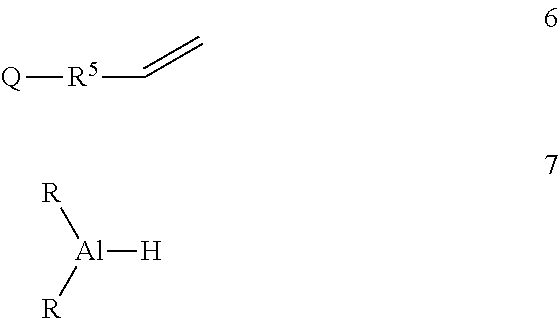



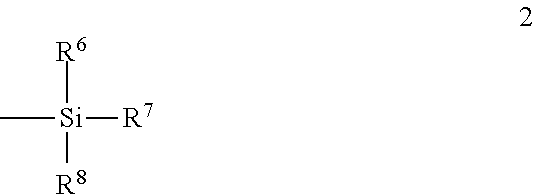



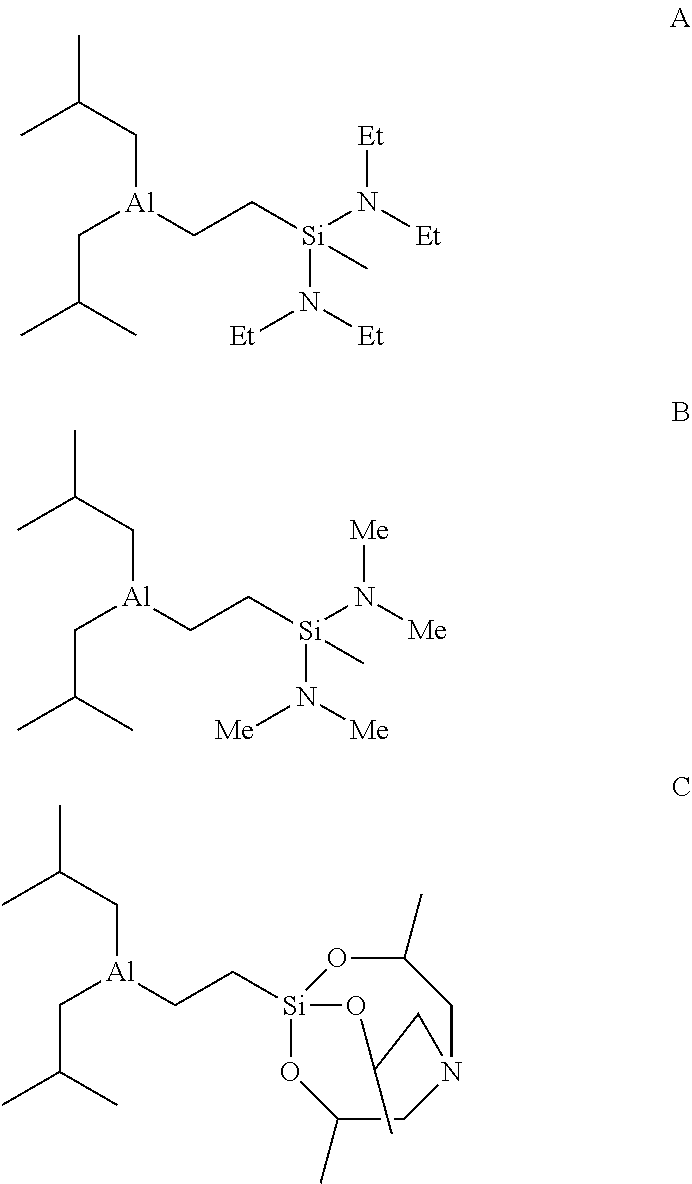

D00000
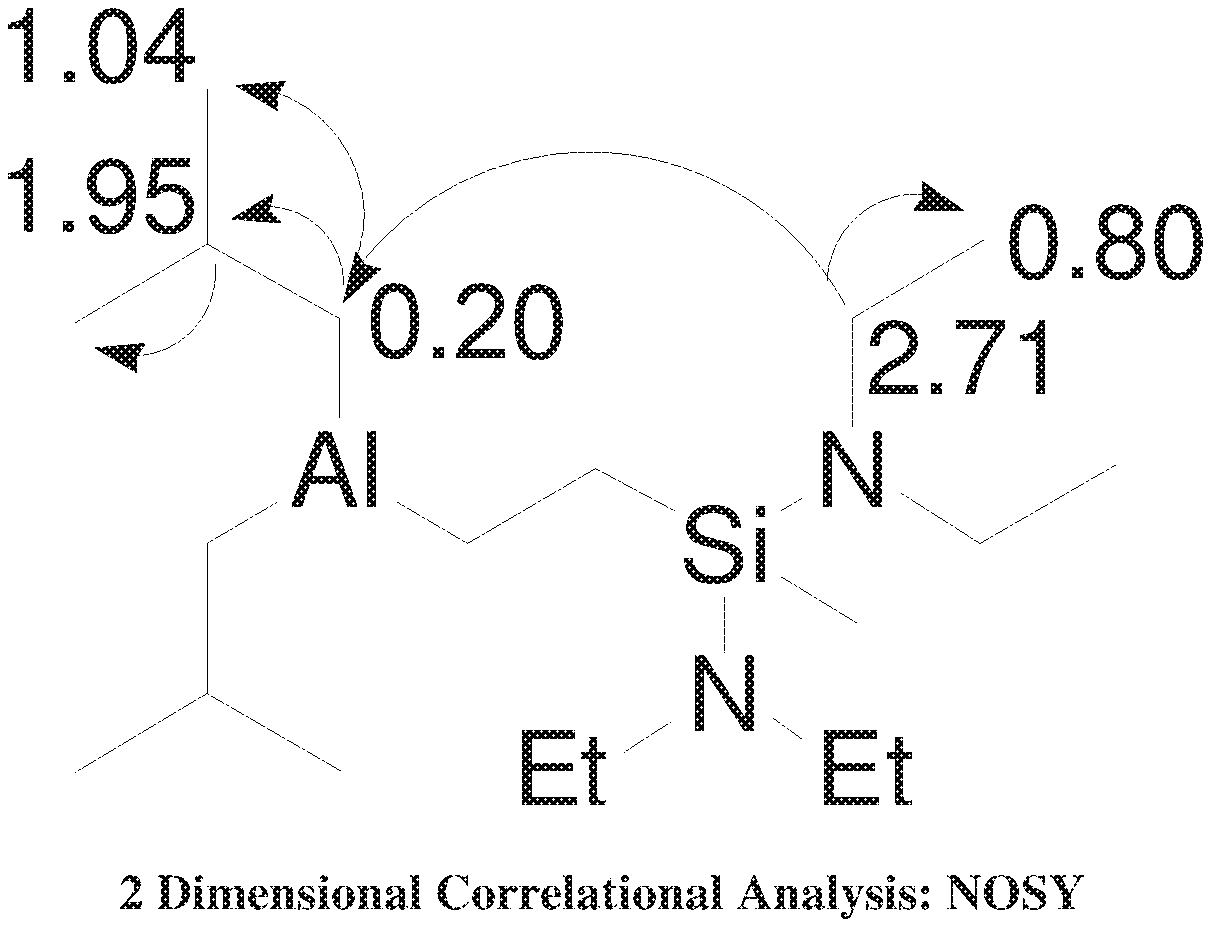
D00001
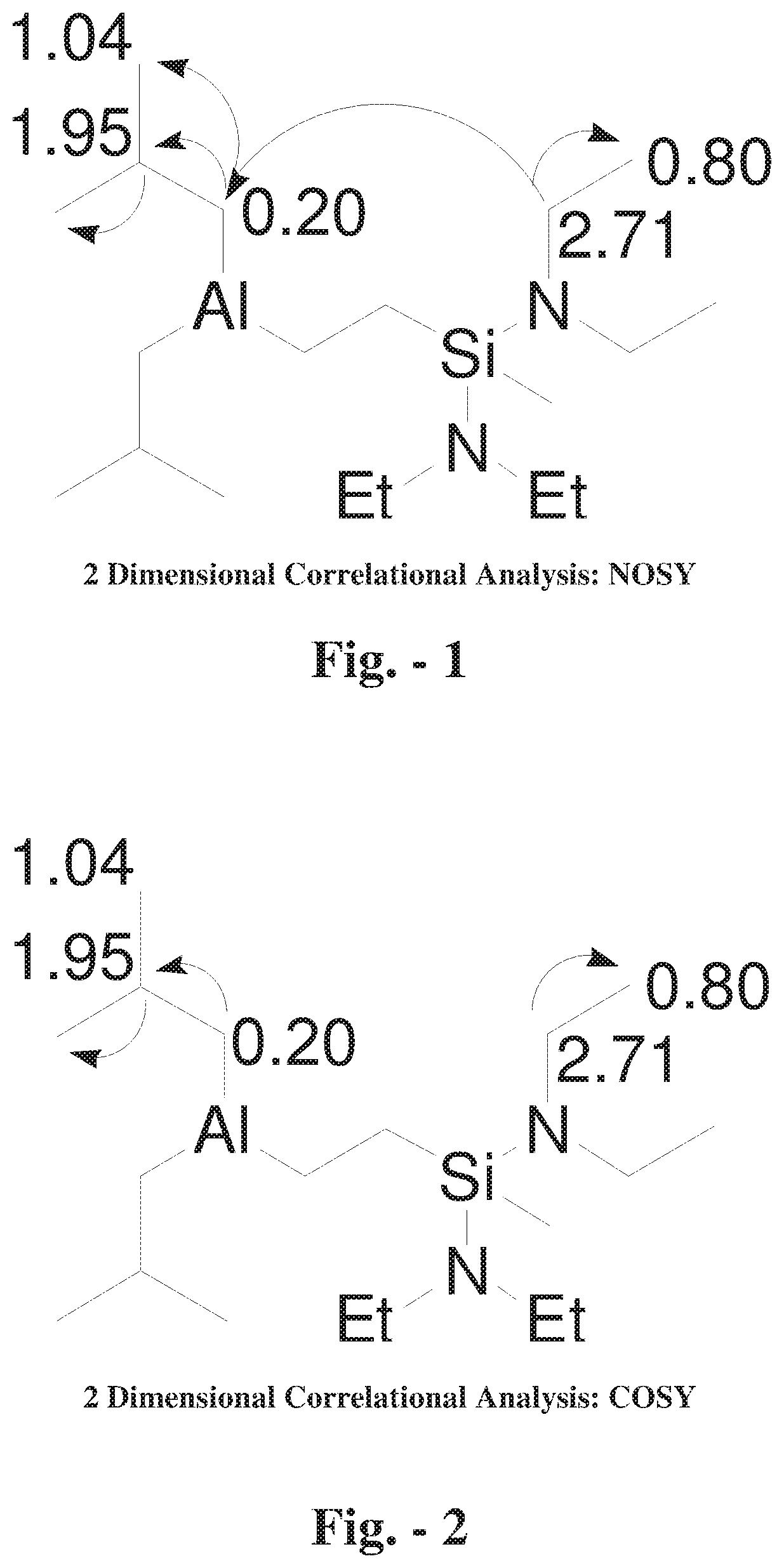
XML
uspto.report is an independent third-party trademark research tool that is not affiliated, endorsed, or sponsored by the United States Patent and Trademark Office (USPTO) or any other governmental organization. The information provided by uspto.report is based on publicly available data at the time of writing and is intended for informational purposes only.
While we strive to provide accurate and up-to-date information, we do not guarantee the accuracy, completeness, reliability, or suitability of the information displayed on this site. The use of this site is at your own risk. Any reliance you place on such information is therefore strictly at your own risk.
All official trademark data, including owner information, should be verified by visiting the official USPTO website at www.uspto.gov. This site is not intended to replace professional legal advice and should not be used as a substitute for consulting with a legal professional who is knowledgeable about trademark law.